Akash Network Review 2024: The Ultimate "Supercloud"?
The sharing economy, which leverages technology to connect people who need specific goods/services with those willing to share them for mutual benefit (often at lower costs), heralded an era where access trumps possession.
Platforms like Uber and Airbnb exemplify this shift, disrupting traditional industries by offering trust, convenience and cost-effectiveness. These innovations challenged conventional business models and promoted sustainability by encouraging sharing rather than discarding unused items or resources.
Akash Network, as a blockchain-based platform for decentralized cloud computing services, aligns with this paradigm.
In this Akash Network review, we will delve into its robust ecosystem, architecture, native utility token, and how it costs a fraction of the money charged by the Big Three cloud services.
Akash Network Review Summary
Akash leverages blockchain technology to create a decentralized marketplace for cloud computing resources. Just as platforms like Airbnb and Uber have transformed the way we access accommodation and transportation, Akash is reshaping the landscape of cloud computing by democratizing access to compute resources.
The Key Features of Akash Network Are:
- Cost Efficiency
- Democratizing Access to GPUs
- World-Wide Accessibility
- Security and Transparency
The Evolution of AI
Artificial intelligence's inception goes back to the 1950s with the work of Alan Turing, who proposed the Turing Test as a means to evaluate a machine's capacity to demonstrate human-like intelligence.
In the subsequent decades, AI research picked up steam and included the creation of the first AI programming language, LISP, by John McCarthy in the 1960s. The 1990s and 2000s saw further progress, demonstrated by IBM's Deep Blue defeating world chess champion Gary Kasparov and the development of speech recognition software.
More recently, AI has blown onto the scene, largely propelled by the development of deep learning techniques and the advent of large-scale neural networks like the Generative Pre-trained Transformer (GPT) series by OpenAI. GPT-3, released in 2020, exemplifies the remarkable progress of AI, boasting natural language understanding and generation capabilities.
However, the rise of AI has spurred challenges and ethical concerns with issues such as privacy, security, algorithmic bias, and transparency taking centre stage.
What is Akash Network?
Akash Network is a cloud computing marketplace, offering a secure, transparent and decentralized platform that connects individuals and businesses seeking computing resources (clients) with those possessing available capacity to lease (providers). It is a Layer-1 protocol built on the Cosmos SDK.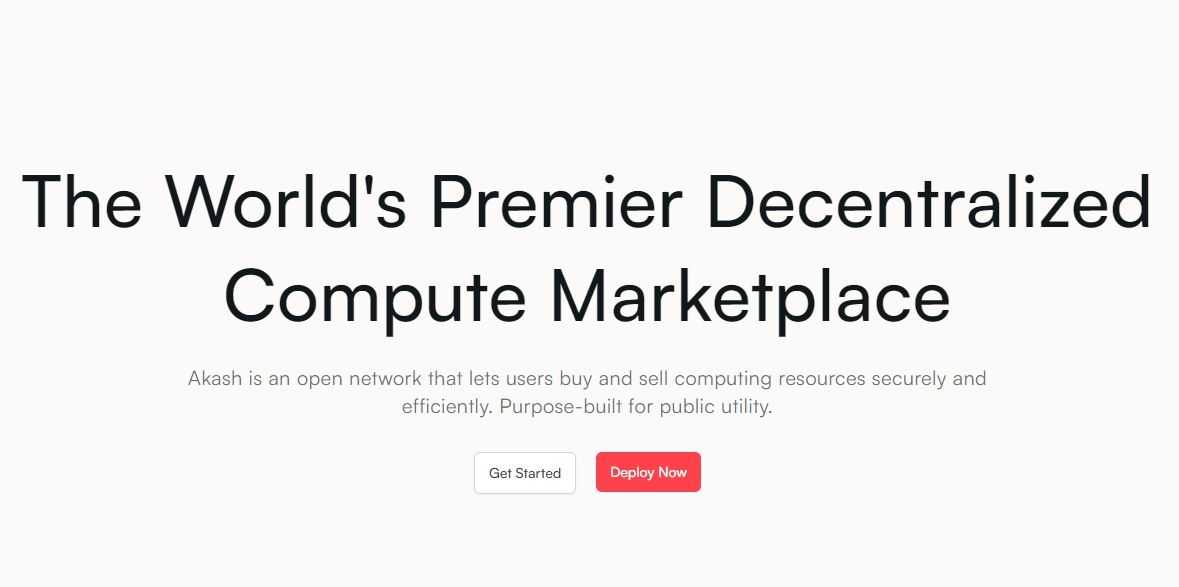
Its architecture positions Akash as a supercloud platform, consolidating various providers under a unified cloud infrastructure, thus presenting clients with a seamless cloud computing experience regardless of their chosen provider. This consolidation not only enhances accessibility but also streamlines the management of computing resources for both clients and providers.
Clients are attracted to Akash for several reasons.
- It provides significant cost advantages compared to traditional cloud computing solutions, allowing them to optimize expenses without sacrificing performance or reliability
- Akash offers a user-friendly interface and intuitive functionalities, making it easy for clients to navigate and utilize its services effectively.
- The platform allows clients to transition between different cloud providers as per their requirements.
- Akash's global deployment capabilities provide clients with enhanced performance benefits, allowing them to leverage computing resources from diverse geographical locations.
Providers also benefit from participating in the network. Whether they have dedicated capacity or temporarily unused resources, providers can leverage Akash to generate profits by leasing out their computing capacity to clients in need. By participating in the Akash Network, providers gain access to a broader market of clients.
Who founded Akash Network?
Akash was founded in 2018 by Overclock Labs, a software development company formed by Greg Osuri and Adam Bozanich.
Osuri's resume includes a two-year stint at IBM as a consultant and founding AngelHack before founding Overclock Labs. Bozanich co-founded Sprouts Tech before founding Overclock Labs.
Akash Open-Source Supercloud for AI
The demand for high-performance GPUs is mainly driven by corporations and hyperscale cloud service providers (CSPs), who possess the necessary resources to acquire and utilize these expensive GPUs.
However, for individuals or smaller-scale users in need of on-demand computing power, accessing such resources can be challenging. Many cloud service users are compelled to accept restricted access and the potential risk of being tied to a single vendor, particularly if the desired GPU units are scarce.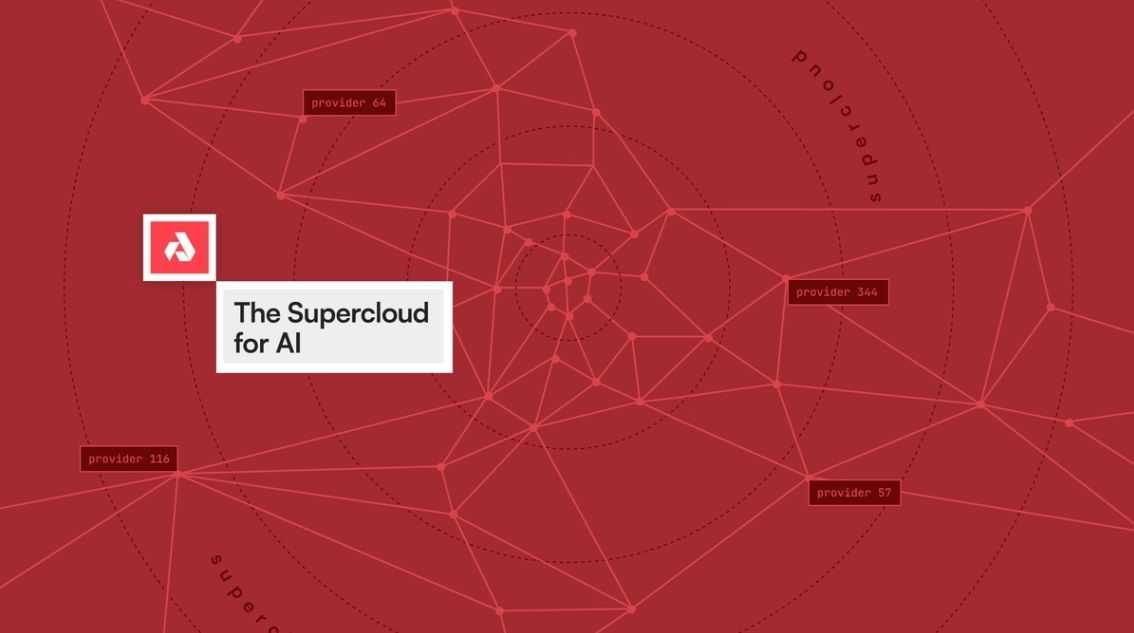
To address these challenges and inefficiencies, Akash introduced the concept of a Supercloud, essentially a decentralized "cloud of clouds" that enables permissionless access to computing resources, including GPUs, from a diverse range of providers, spanning from independent entities to hyperscale corporations.
This went live in August 2023 with the network's sixth mainnet upgrade, which opened up a marketplace for high-density GPUs.
How Does Akash Network Work?
Computing resources like CPU, memory, and disk space are leased out in units called containers. Think of containers like sealed packages containing all the necessary ingredients for running an application smoothly, such as code, tools, libraries and settings. These containers ensure that the application runs consistently regardless of the computing environment it's deployed in.
To create these containers, anyone with a computer or server can use a process called virtualization. One popular virtualization tool is Docker, which simplifies the process of creating and managing containers. These containers are often referred to as "docker images."
When a developer wants to lease a container, they request a deployment by specifying the type and quantity of computing units they need. For example, they might specify that they need a container with a certain amount of CPU power and memory. They can also specify attributes like the region where they want their container to be located or any privacy features they require. Additionally, they can set a maximum price they are willing to pay for each type of computing unit.
Once the request is made, an order is created in the order book, which is a list of available containers. Providers who have containers that match the requirements of the order then compete by placing bids. The provider who offers the lowest price that meets all the requirements of the order wins the bid, and a lease agreement is created between the developer and the provider.
For each successful lease, a portion of the lease amount, known as the Take Fee, is paid to the stakers, incentivizing them to support the network and ensure its smooth operation.
Akash Network Architecture
Akash Network's architecture is comprised of several components, each serving a distinct role in enabling its functionality and operation.
Blockchain Layer
At the core of the network lies the blockchain layer, built upon Tendermint Core and Cosmos SDK. This layer ensures a secure and scalable consensus mechanism, overseeing tasks such as maintaining the distributed ledger, managing validators, governance processes and facilitating token transactions involving the Akash token (AKT).
By leveraging Tendermint Core's Byzantine Fault Tolerant (BFT) consensus engine and the modular capabilities of Cosmos SDK, the blockchain layer upholds the security and decentralization principles fundamental to Akash Network's design.
Application Layer
The application layer is responsible for orchestrating the deployment of applications, managing resource allocation, and overseeing the lifecycle of deployments within the Akash ecosystem.
Users interact with this layer to submit deployment configurations, specifying their requirements such as computing resources, storage and geographic preferences. Orders are then generated based on these configurations and broadcast across the network, prompting providers to place bids for the available resources. Upon selection of the winning bid, a lease agreement is established between the user and the provider, facilitating the deployment process.
Provider Layer
This layer comprises data centres, cloud providers and individual server operators who contribute their resources to Akash Network.
Leveraging software components like the Provider Daemon, providers manage their resources, communicate with the blockchain, and handle resource allocation for deployments. Container orchestration systems such as Kubernetes or Docker Swarm aid in managing the deployment and scaling of user applications.
User Layer
This layer caters to individuals and businesses seeking computing resources for deploying and managing their applications on the Akash network.
Users interact with the network through various tools and interfaces, including the Akash Client, which offers a command-line interface for interacting with the network, and the Akash Console, a web application providing a dashboard for deployment monitoring and administration. Additionally, the Akash Cloudmos Dashboard offers a graphical user interface for intuitive interaction, allowing users to manage deployments and monitor resources.
Akash Network Ecosystem
From decentralized finance to gaming to AI & ML projects, Akash Network boasts a robust ecosystem and several protocols have been deployed on Akash.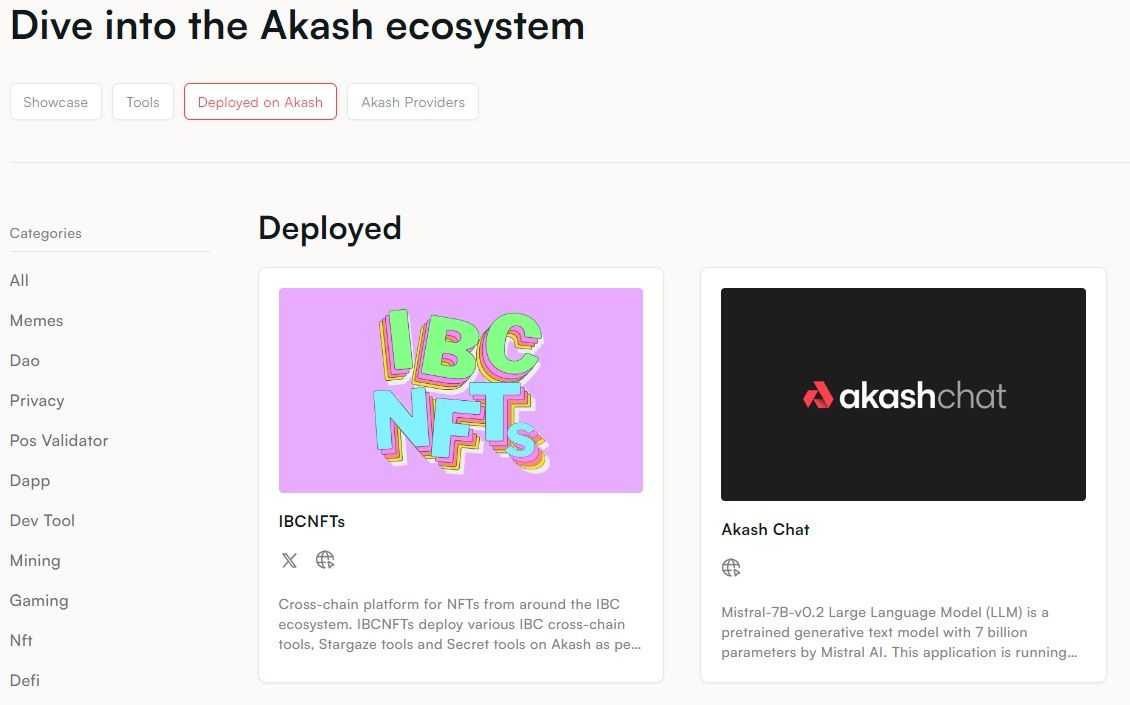
Here's a sampling:
- Gaming: This category lists two games — Passage 3D, a connected virtual world, and Strange Clan, a play-to-own game where players farm, craft and go on quests with their clans.
- DeFi: The DeFi section lists seven projects, including Chandra Station, an omni-chain decentralized exchange (DEX) on Cosmo; Osmosis DEX; multichain DEX/bridge aggregator Rango Exchange; and REStake, which allows validators to auto-compound their staking rewards.
- AI & ML: SDXL, a text-to-image model from Stability AI, and Thumper AI, another text-to-image model, are among the projects listed.
- Decentralized Autonomous Organization: Philanthropy-focused AtlasDAO, a Minecraft server governed by the Craft DAO, and the community accelerator for NETA are among the DAOs listed deployed on Akash Network.
AKT Token
The AKT token is the utility token of the Akash Network that serves many purposes:
- Community Governance: All aspects of Akash Network are governed by its community of AKT holders. Through voting on proposals, holders steer network improvements and manage critical parameters like inflation rates and take rates.
- Securing the Network: Akash Network relies on a proof of stake blockchain for its security, with the staking of AKT tokens serving as the primary mechanism. Stakers not only bolster the network's security but also enjoy a passive income stream.
- Utility as a Value Exchange: AKT acts as the default mechanism for storing and exchanging value within the Akash Network ecosystem. It also functions as a reserve currency within the broader Cosmos network, facilitating multi-currency and multi-chain interactions.
- Incentivizing Participation: In addition to its utility, AKT serves to incentivize participation in the network and ecosystem. This incentivization mechanism fosters community engagement and drives activity within the network.
AKT has a maximum supply of 388.5 million. According to CoinGecko, it is ranked as the 104th largest crypto by market capitalization, which stood at $826.5 million as of Feb. 15.
AKT's current price represents a decline of about 60% over the all-time high price of $8.07, which it achieved in April 2021.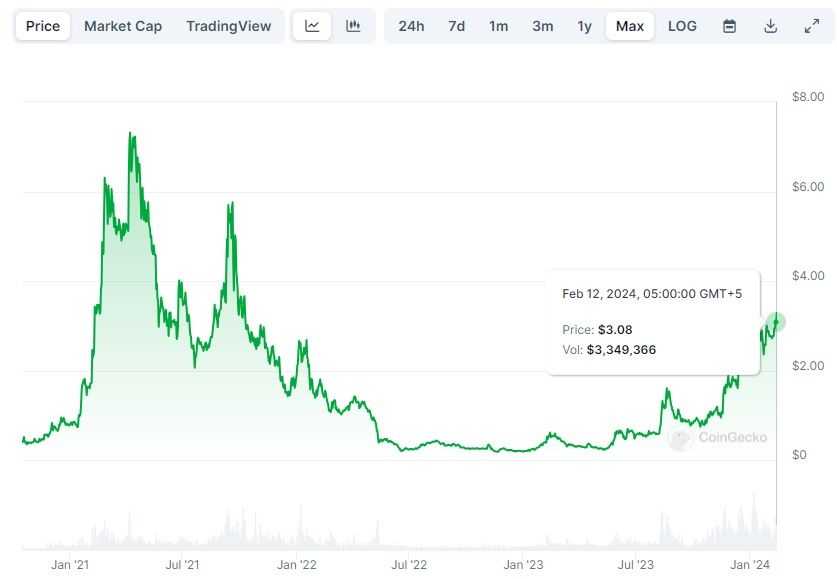
Where to Buy AKT?
If you're looking to get your hands on AKT, you can check out centralized exchanges like Crypto.com, Kraken, KuCoin and Gate.io. If you're more into decentralized exchanges, you can buy the coin through Osmosis.
Where to Store AKT?
The Akash Network is built on top of Cosmos. As a result, wallets that support the Cosmos ecosystem work with AKT. Akash Network recommends wallets like Leap, Keplr, Cosmostation, Mixin and Omni Wallet.
AKT 2.0
Certain limitations of AKT have emerged that necessitated refinement to ensure long-term sustainability and scalability.
Price Volatility Concerns: Initially, AKT was used to pay for hosting services, with pricing determined at lease initiation. However, the fluctuating value of AKT over time poses challenges, potentially leading to discrepancies between agreed-upon prices and actual costs for providers and tenants.
Early Stage Dynamics: Akash Network is in its nascent stage, experiencing early product market fit. While demand is growing, it has not yet reached a level where providers are incentivized to commit significant computing resources.
Insufficient Community Fund: The size of the community fund is currently inadequate to effectively stimulate the growth of the Network, limiting its potential expansion and development.
Token Value Accrual: To ensure the network's security and viability, the AKT token must accrue value beyond just serving as an incentive mechanism. This requires strategies to enhance its utility and attractiveness to stakeholders.
Say hello to AKT 2.0, an ongoing effort to bring new token features and utility to Akash Network and the AKT token.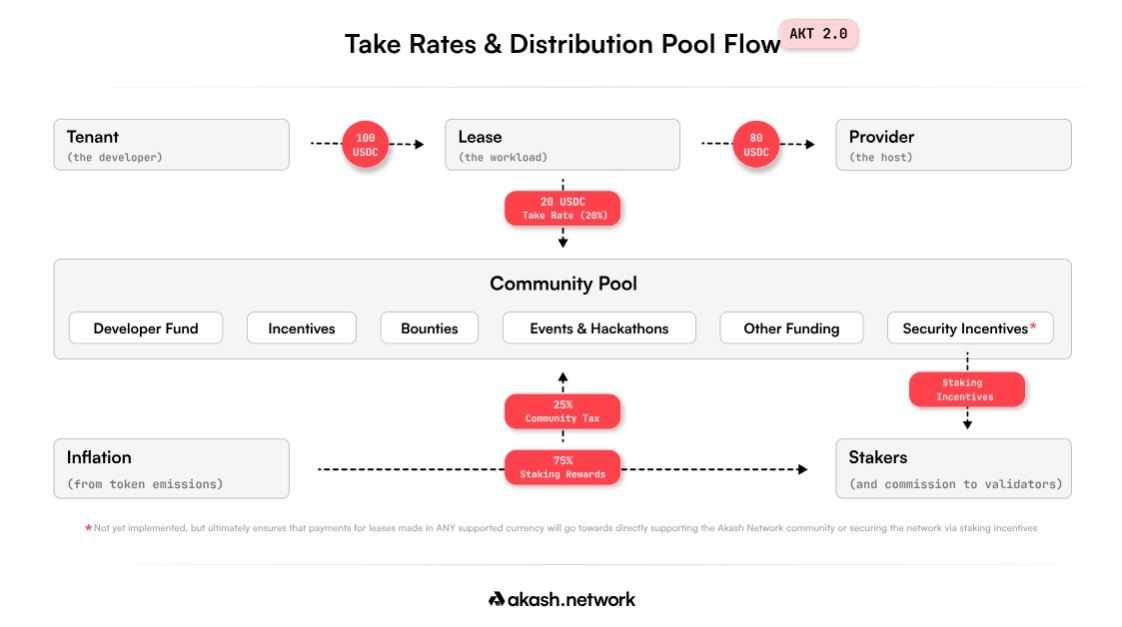
Two features of AKT 2.0 have gone into effect:
The following three improvements are currently in the works.
- Incentive Distribution Pool: This pool comprises a selection of whitelisted currencies and AKT, disbursed to network participants as rewards for their contributions. Funding for this pool is sourced from collected fees, including the take and make fees, as well as inflationary rewards. Distribution from the pool is allocated among the following participants, with specific portions determined by the network through on-chain governance.
- Provider Subsidies: During the initial stages of the network's development, it becomes imperative to subsidize providers to guarantee an ample supply of computing power, enabling the network to offer competitive prices to tenants. Several approaches to provider subsidization are under consideration, including covering operational and amortized hardware costs over a specified period and implementing incentives based on the quantity of workload hosted, akin to the Filecoin Plus Program, adopting an exponential discount model.
- Public Goods Fund: A portion of the tokens from the incentive distribution pool would be used to establish the fund, aiming to incentivize the expansion of the Akash Network. This fund comprises AKT tokens distributed to developers contributing to the development of applications that enhance the Akash Network and drive its adoption. The distribution of the developer fund would be governed by on-chain governance, with the mechanism for allocation to be determined by the Steering Committee.
How Much Does Akash Network Cost?
Hosting your application on Akash will incur about one-third of the cost compared to using Amazon AWS, Google Cloud Platform and Microsoft Azure.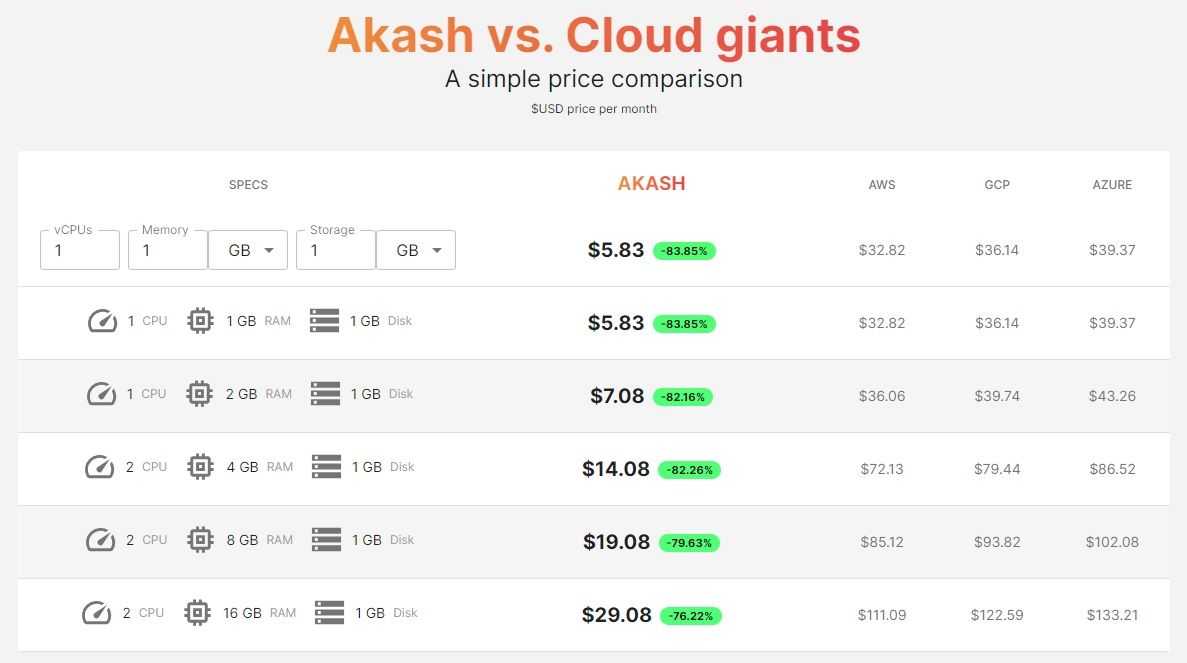
This table is a price comparison between Akash and major cloud service providers. It provides the cost in USD per month for different specifications of virtual machines (VMs) or instances, including the number of vCPUs (virtual central processing units), memory (RAM) in gigabytes (GB), and storage in GB.
The table compares the prices for various configurations of VMs, ranging from a basic setup with 1 vCPU, 1 GB RAM and 1 GB disk storage to more advanced configurations with higher CPU and RAM capacities. For each configuration, the table displays the monthly price for Akash and the cloud giants (AWS, GCP, Azure) in US dollars, along with the percentage difference between Akash and each cloud provider.
As you can see, the prices listed suggest that Akash offers significantly lower costs compared to AWS, GCP and Azure for similar VM configurations, with percentage savings ranging from approximately 76% to 83%.
Advantages of a GPU Marketplace for AI Hosting
A GPU marketplace for AI hosting presents several advantages.
Firstly, it offers access to specialized hardware optimized for AI and machine learning tasks, particularly GPUs renowned for their parallel processing capabilities. Akash, for example, lets users access the Nvidia H100 and Nvdia A100, two of the most powerful GPUs that market some of the most powerful generative AI systems.
In addition, these marketplaces provide scalability, allowing users to scale their computational resources according to demand, minimizing underutilization or overprovisioning. The pay-as-you-go model enhances cost efficiency by eliminating the need for upfront hardware investments.
These GPU marketplaces also expedite time-to-market by enabling quick deployment of AI models and applications without hardware procurement delays. They also offer a diverse ecosystem of tools and services tailored for AI development, streamlining workflows and enhancing productivity. Global accessibility ensures users can access GPU resources from anywhere.
Closing Thoughts
By embracing the principles of the sharing economy and decentralized technologies, Akash has unlocked new possibilities in accessing computing resources, democratizing GPU usage, and driving down costs for users.
The platform's robust ecosystem, anchored by its native utility token AKT, fosters collaboration, innovation, and community governance. With its commitment to continuous improvement, as evidenced by the ongoing AKT 2.0 initiative, Akash Network is poised to shape the future of cloud computing, AI hosting, and beyond.
Akash Network presents a refreshing alternative to conventional cloud service providers, providing individuals and businesses with unprecedented flexibility, efficiency, and cost-effectiveness in accessing computing resources.






































